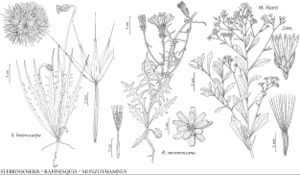Stebbinsoseris
Amer. J. Bot. 78: 1024. 1991.
| Taxon | Illustrator ⠉ | |
|---|---|---|
 | Stebbinsoseris heterocarpa Rafinesquia neomexicana Munzothamnus blairii | Yevonn Wilson-Ramsey Bee F. Gunn Bee F. Gunn |
Annuals, 1–10 cm; taprooted. Stems 0, or erect, mostly unbranched, glabrous or lightly scurfy-puberulent. Leaves usually all basal; petiolate (petioles narrowly attenuate, usually scurfy-puberulent, especially proximally); blades linear to narrowly oblanceolate, bases slightly clasping, margins entire or irregularly dentate or lobed (teeth and lobes narrow, acute, straight or arcuate, faces glabrous or minutely scurfy-puberulent). Heads borne singly (often inclined in bud, erect in flowering and fruit). Peduncles not notably inflated, usually ebracteate (glabrous or ± scurfy-puberulent, especially distally). Calyculi of (3–) 4–14, deltate or ovate to lanceolate bractlets. Involucres campanulate, (3–) 5–35 mm diam. (fusiform to ovoid in fruit). Phyllaries (4–) 5–18 in ± 2 series, (green or purple) mostly lanceolate, subequal to equal, herbaceous, apices acute, faces glabrous. Receptacles flat, ± pitted, glabrous, epaleate. Florets (10–) 30–125; corollas yellow or white, outer often purplish abaxially (equaling or surpassing phyllaries by 1–3 mm). Cypselae brown, purplish gray, stramineous, or violet, sometimes purple-spotted, columnar or truncate-fusiform, not beaked, ribs 10, ± scabrellous or spiculate, faces glabrous or (on outer) strigose; pappi persistent, of 5, usually yellowish or brownish, rarely white, aristate scales (bodies straight or arcuate, lanceolate, usually glabrous, margins plane or involute, apices erose or notched, aristae shorter than to equaling bodies, barbellulate). x = 18.
Distribution
sw United States, nw Mexico
Discussion
Species 2 (2 in the flora).
Stebbinsoseris comprises two allotetraploid species derived from hybrids between Microseris and Uropappus. The justification for raising these species to generic rank was given in R. K. Jansen et al. (1991b), where molecular data were presented supporting the separation of Uropappus from Microseris. Stebbinsoseris and Uropappus were ranked as sections of Microseris in earlier taxonomic treatments (K. L. Chambers 1955, 1960). Because of its hybrid origin, Stebbinsoseris is intermediate in critical taxonomic traits of habit, involucre, and fruits (C. Irmler et al. 1982), and it is separated from its parental taxa by rather minor differences. Chloroplast DNA studies show that Microseris douglasii and M. bigelovii were the maternal parents of the tetraploid hybrids (R. S. Wallace and R. K. Jansen 1990). That Uropappus lindleyi was the staminate parent of those crosses is confirmed by nuclear rDNA evidence reported by Wallace and Jansen (1995).
Selected References
None.
Lower Taxa
Key
| 1 | Cypselae narrowly truncate-fusiform, brown to purplish, 5–8 mm, apices not widened at bases of pappi; pappus scale bodies 3–5 mm; coastal central California | Stebbinsoseris decipiens |
| 1 | Cypselae narrowly truncate-fusiform to columnar, gray to pale brown or violet (dark purplish in sw California), 4.5–12 mm, apices slightly widened at bases of pappi; pappus scale bodies 4–11 mm; widespread, rarely coastal except in sw California | Stebbinsoseris heterocarpa |
"fine" is not a number.